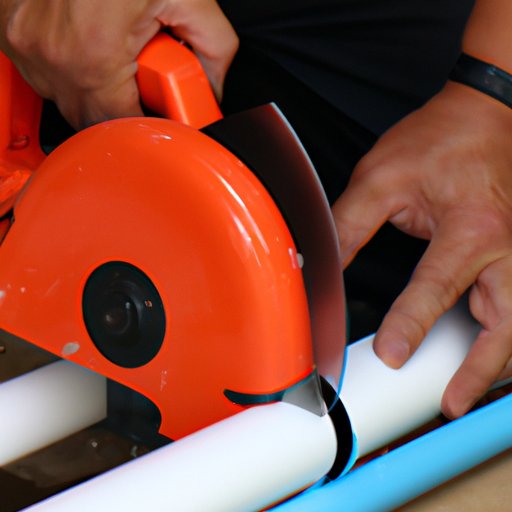
Introduction
Have you ever found yourself struggling to cut a PVC pipe straight or achieving a clean edge? You’re not alone! Cutting PVC pipes can be tricky and can lead to uneven edges or even ruined projects if done incorrectly. In this article, we’ll explore various methods for cutting PVC pipes and how to achieve the best results based on your project needs. Whether you’re a DIY enthusiast or a professional plumber, this guide will help you achieve the best results when cutting PVC pipes.
5 Common Methods for Cutting PVC Pipe: Which One Works Best?
There are several methods for cutting PVC pipes, each with its own advantages and disadvantages. Some common methods include using a handsaw or hacksaw, a miter saw, a circular saw, or a jigsaw. The best method for cutting PVC pipes depends on the specific project requirements.
For example, if you need to make quick and easy cuts on a small PVC pipe, using a handsaw or a hacksaw may be the best method. However, if you’re working on a large project that requires precise cuts, using a miter saw or a circular saw may be more effective.
Ultimately, understanding the pros and cons of each method is crucial in determining the best cutting method for your project.
DIY Guide: How to Cut PVC Pipe with Precision
If you don’t have access to a power saw, don’t worry! You can still achieve precise cuts using a handsaw or hacksaw. Here’s how:
- Mark the cut line on the PVC pipe using a pencil or marker.
- Secure the PVC pipe in a vice or clamp to keep it steady.
- Put on safety goggles and gloves to protect your eyes and hands.
- Using a handsaw or hacksaw, cut slowly and steadily along the marked line. Avoid applying too much pressure, as this can cause the PVC pipe to crack.
- Sand the edge of the pipe using sandpaper, a file, or a deburring tool to remove any roughness and ensure a clean, smooth cut.
Keep in mind that this method may take longer than using a power saw, but it can be just as effective in achieving clean and straight cuts.
Quick Tips for Cutting PVC Pipe Without Power Tools
If you don’t have access to power tools, there are still several ways to cut PVC pipes using everyday household items. Some methods include using a handsaw, a hacksaw, a utility knife, a hot wire cutter, or even a string or dental floss. While these methods may not be as quick or precise as using a power saw, they can still achieve decent results with some practice.
One important thing to keep in mind when using these methods is to take safety precautions, as some items can be hazardous when used improperly. For example, when using a utility knife, be sure to keep your fingers away from the blade to avoid injury.
The Benefits of Using a PVC Pipe Cutter for Cutting Projects
PVC pipe cutters are specially designed for cutting PVC pipes and offer several advantages over other cutting methods. They can cut through PVC pipes quickly and easily, and can make precise cuts without leaving rough edges. They are also relatively inexpensive and can be used for a variety of projects.
PVC pipe cutters come in different sizes and styles, including handheld cutters and ratcheting cutters. For projects that require frequent cutting, using a PVC pipe cutter can save a significant amount of time and effort.
Pro Tips: How to Cut PVC Pipe for Plumbing Projects
When it comes to plumbing projects, proper cutting techniques are crucial for ensuring tight and secure joints. Here are some pro tips for cutting PVC pipes for plumbing projects:
- Choose the right cutting tool for the job. Depending on the project requirements, a handheld PVC pipe cutter, a miter saw, or a circular saw may be most effective.
- Measure the length of the pipe precisely and mark the cut line with a pencil or marker.
- Make sure the blade of the cutting tool is clean and sharp to ensure a clean cut.
- Use a deburring tool or sandpaper to smooth out any rough edges on the cut end of the pipe.
- Apply PVC cement to both ends of the pipe and the fitting before joining them to ensure a watertight seal.
How to Get Professional Results When Cutting PVC Pipe: A Step-by-Step Guide
If you’re looking to achieve professional results when cutting PVC pipes, follow these steps:
- Determine the project requirements and choose the best cutting tool and method accordingly.
- Measure and mark the cut line precisely on the PVC pipe.
- Secure the PVC pipe in a vice or clamp to keep it steady.
- Put on safety goggles and gloves, and follow all safety precautions when using power tools.
- Cut the PVC pipe slowly and steadily along the marked line, applying just enough pressure to ensure a clean cut.
- Sand or debur the cut end of the pipe to remove any roughness or burrs.
By following these steps, you can achieve professional results when cutting PVC pipes, whether for a small DIY project or a large plumbing job.
Conclusion
When it comes to cutting PVC pipes, there are several methods to choose from, each with its own advantages and disadvantages. By understanding the specific project requirements and choosing the best cutting method accordingly, you can achieve the best results with minimal effort. Whether you’re using a power saw or a handsaw, be sure to follow all safety precautions and practice good cutting techniques to get the best results.




